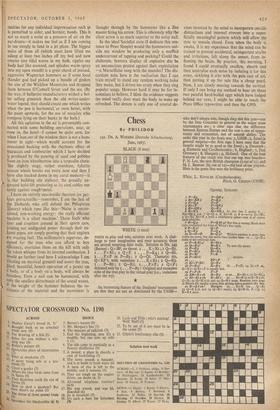Chess
By PHILIDOR
250. DR. A. WarAwA (Deutsche Schachzeitung, June, 1965) BLACK (8 men)
WHITE (7 men)
WHITE to play and win; solution next week. A chal- lenge to your imagination and your accuracy; there are several tempting false trails. Solution to No. 249 (Barnes) : Q x BP, no threat. I . . . K x Kt ; 2 Q—Bs. x...PxKt; 2 QxP. x P—K4; 2 Q--.BI. P x P or P—B3 ; 2 Q—Q6. Thematic try, Q x KP ?, with variations K x Kt ; 2 (11—K3. P—B6; 2 Q—K7. r ...PxP; 2 QxP; defeated only by x . . . P—B3 I Original and attractive echo of the true play in the virtual play (i.e., variations after the try).
An interesting feature of the Students' tournaments are that they are not so dominated by the USSR— who don't always win, though they did this year—nor by the Iron Countries in general as the major team tournaments are ; a clear sign that the difference between Eastern Europe and the rest is one of oppor- tunity and economics, not of natural ability. The order this year in the finals was: r, USSR ; 2, Israel (a general surprise—the first sign I have seen that the Israelis might be as good as the Jews) ; 3, Denmark ; 4, Rumania and Czechoslovakia ; 6, England ' • 7, East Germany; 8, Hungary ; 9, Holland. One of the best features of our result was that our top two boards— P. N. Lee, the new British champion (7 out of iz), and M. J. Basman (8/ out of x2)—did best of our players. Here is the game that won the brilliancy prize.
White, L. KOVALEK (Czechoslovakia). Black, G. CRoDos (USSR).
Opening, SICILIAN.
z P—K4 P—QB 4 a Kt—KB,' p—K 3 3 Pr34 P x P 4 Kt x P-1R 3 3 Kt—QB 3 2 6 B—K 3 7-KB 3 In this line I prefer 6...
.
Kt-L-Q11i1 3, e.g. 7 Q—Q 2, K Kt--K 2; 8 0-0-0, Kt x Kt; 9 Q x t, Kt—B 3, With a satisfactory game—text is of course quite _playable. 7 R-93 P-9 Kt 4? But this is wrong; Black must haveP—K overlooked the forceQ x of White's fine reply.
8
9 Q—B 3 P-9 4 .to 0-0-0 I3,--Q 3? White's position is more than worth the pawn, but this move loses further time. to ... Q—I3 2 looks to me relatively best.
rz P—K Kt 4! B—Kt a
52 Q—R,31 B—K s To save the queen. 53 P—B Q—B a 4 P—Kt 5 Rt—K 3
55 B x Kt P x B
riS P—Kt 6! 'i . . decisive. x7...! BPxP Kix P (K6) Q—B r re P—B 51 K--B 2 r8 ... PxP; 19 Kt xP ch, K—B r; 20 Xt xP is equally bad.
ig P x P ch Px P
so KR—B r ch B—B 3 or 20 . . .K—Kt I; 21 Q-1(1 4 2l Kt—Kt 5 ch K—Kt r = . . . K—K 2; 22 B—B 5 ch, Q xB; 23 Q—K 6 di and 24 Q—B 7 mate. Russians have gone to Siberia for smaller crimes than getting into a position like this. 22 R—Q 8 ch 1 Resigns 22 . . . B x R (22 ., . Q x R; 23 Q—K 6 ch and 24 Q---13 7 mate); 23 Q x R ch, N. x Q; 24 R—B 8 mate.






































 Previous page
Previous page